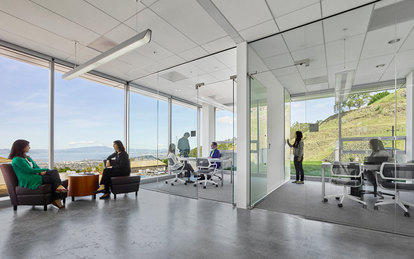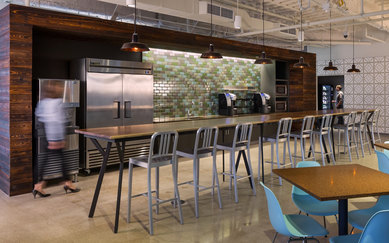Biosafety Best Practices to Help Inform Everyday Environments

SmithGroup’s Science & Technology Practice Director and Senior Lab Planners collectively envisioned what non-scientific environments could learn from laboratory biosafety measures. With a healthier, safer environment as a feasible outcome, it is a possibility worth considering.
Laboratories are currently the most highly conditioned, calibrated and filtered spaces in the physical environment. Lab user safety and the preservation of research assets is a high stakes game and biosafety is a top priority and always on the minds of staff. Specialized planning and design criteria are critical to create and support lab infrastructure, systems, practices, policies and procedures. Behavioral conduct is ingrained and there is a cultural understanding of the collective need to maintain the integrity of these high-performance spaces.
The spread of the COVID-19 pandemic across the globe has created an elevated awareness of the need to protect ourselves and each other from biological hazards. We asked ourselves what basic measures that are common practice in labs could be transferred and applied to non-scientific offices, educational environments, and other gathering spaces to increase wellness, peace of mind and safety?
Laboratories rely on both physical facility design and operational practices and protocols to achieve an increased level of user protection. Research spaces comprise some of the highest cost per square foot for construction and operation, but there are valuable behavioral, procedural, operational and design/construction measures that can inform everyday environments. These range from relatively affordable procedural adjustments to more aggressive measures that may require significant investment. We will explore this spectrum of effort and return.
SHORT-TERM SOLUTIONS - POLICIES TO PROMOTE HEALTH
Organizations could implement policies and procedures learned from a bio-secure lab to impact how office and other communal environments function. By adopting, communicating and enforcing policies and procedures that mirror those in research environments, offices and other gathering spaces could reap health benefits with limited investment. Potential policies and procedures include:
- Create standard operating procedures based on risk assessments.
- Require frequent handwashing (e.g. before and after meetings).
- Institute dedicated eating areas and discourage eating at desks.
- Establish tier-based illness policies to help employees understand the required response. These tiers and responses could be defined by each organization, for example:
- Tier 1 - Common Cold
- Tier 2 - Influenza / Norovirus
- Tier 3 – COVID-19
- Update illness and benefit policies to enable remote work in order to support staff members to work from home, if necessary, while recovering from illness.

Establishing dedicated dining areas and discouraging eating at desks can help reduce the chance of contamination.
MIDTERM CONSIDERATIONS - ADOPTING NEW CULTURAL & BEHAVIORAL NORMS
The psychology behind what we can accomplish with building safety is profound, but many people resist change, oftentimes because they don’t perceive a direct personal benefit. The adoption of new cultural standards surrounding new policies and procedures requires collective support by those directly affected. The hope is that after living through a frightening COVID-19 pandemic, most people would want to institute measures to continue to protect themselves and others. Some considerations include:
- Instill a mindset to maintain a clean and safe work environment as a critical priority, from the very onset of onboarding new employees.
- Create an expectation for staff to clean and disinfect workspaces, pantry countertops, etc., throughout the workday. As commonly seen in gyms where you clean your own equipment before and after using it, lab users disinfect their own countertops in between each task.
- Use absorptive pads to cover shared work surfaces to reduce contaminants. Scientists commonly have absorptive pads in labs so that users can cover work surfaces to avoid depositing or picking up contaminants from the countertop, even when the surface has been wiped down and cleaned.
- Increase frequency of cleaning shared equipment, tools, and spaces such as copiers, eating spaces, conference rooms, video equipment, kitchens/pantries and restrooms.
- Recommend that staff use good personal hygiene practices. Any staff person showing symptoms of illness should be encouraged to stay home. In 2015, the Center for Disease Control & Prevention (CDC) reported that worker illness and injury costs employers $225.8 billion annually[1].
- Supplying masks and gloves for people who start to feel ill. It is likely that use of these items will be more culturally accepted after the COVID-19 pandemic, like the wider acceptance of face masks in many Asian countries after SARS.
LONG-TERM INVESTMENTS - PROVIDING A HEALTHIER FACILITY
If organizations are truly committed to improving their work settings to include the physical environment, infrastructure investments can go a long way toward long-term healthy environments, employee wellness and subsequently more productivity and fewer employee sick days. Planning and design strategies taken from research environments might include:
- Install sanitizer stations at building entrances and throughout the facility
- Install dedicated handwashing stations in kitchens separate from food prep sinks
- Use technology to automate functions to limit touching shared surfaces. Install automatic faucets, hand towel dispensers, voice command equipment, etc.
- Laboratory process-related needs often lead lab designers to tighter relative humidity controls than those found in the typical office environment. Keeping Relative Humidity between 40% to 60% reduces the potential for microbial propagation in staff and is shown to increase human response to disease, reduce sick time and improve cognition and productivity. Increased humidification to meet this range is based on building and seasonal constraints.
- Select furniture, fixtures and materials to mitigate bio-contamination risk. For example, consider microbial-resistant fabrics and materials, and non-porous and non-organic surfaces that respond well to the harsh cleaning products required for effective disinfection.
- In many lab environments, coats and shoes are removed and personal protective equipment is worn to decrease contamination. This approach does not seem realistic in everyday environments where people congregate. However, in workplaces, personal lockers, coat and shoe closets could be located near entrances to encourage the removal of street shoes and coats.
Laboratories are highly biosecure environments that can lend us insight into best practices for policies, procedures, and operations. Behavioral, planning and design strategies for non-scientific environments can improve health and safety significantly. A new, keen awareness has been reached by many and the COVID-19 pandemic could be the impetus for real change. Stay well.
